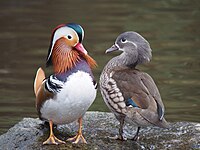
Photo from wikipedia
Sexual dimorphism (SD) is a common feature of animals, and selection for sexually dimorphic traits may affect both functional morphological traits and organismal performance. Trait evolution through natural selection can… Click to show full abstract
Sexual dimorphism (SD) is a common feature of animals, and selection for sexually dimorphic traits may affect both functional morphological traits and organismal performance. Trait evolution through natural selection can also vary across environments. However, whether the evolution of organismal performance is distinct between the sexes is rarely tested in a phylogenetic comparative context. Anurans commonly exhibit sexual size dimorphism, which may affect jumping performance given the effects of body size on locomotion. They also live in a wide variety of microhabitats. Yet the relationships among dimorphism, performance, and ecology remain underexamined in anurans. Here, we explore relationships between microhabitat use, body size, and jumping performance in males and females to determine the drivers of dimorphic patterns in jumping performance. Using methods for predicting jumping performance through anatomical measurements, we describe how fecundity selection and natural selection associated with body size and microhabitat have likely shaped female jumping performance. We found that the magnitude of sexual size dimorphism (where females are about 14% larger than males) was much lower than dimorphism in muscle volume, where females had 42% more muscle than males (after accounting for body size). Despite these sometimes‐large averages, phylogenetic t‐tests failed to show the statistical significance of SD for any variable, indicating sexually dimorphic species tend to be closely related. While SD of jumping performance did not vary among microhabitats, we found female jumping velocity and energy differed across microhabitats. Overall, our findings indicate that differences in sex‐specific reproductive roles, size, jumping‐related morphology, and performance are all important determinants in how selection has led to the incredible ecophenotypic diversity of anurans.
Journal Title: Journal of Evolutionary Biology
Year Published: 2023
Link to full text (if available)
Share on Social Media: Sign Up to like & get
recommendations!